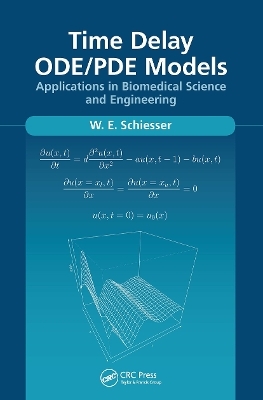
Time Delay ODE/PDE Models
Applications in Biomedical Science and Engineering
Seiten
2023
CRC Press (Verlag)
978-1-032-65432-4 (ISBN)
CRC Press (Verlag)
978-1-032-65432-4 (ISBN)
The intent of this book is to present a methodology for the formulation and computer implementation of mathematical models based on time delay ordinary differential equations (DODEs) and partial differential equations (DPDEs) in biomedical science and engineering (BMSE).
Time delayed (lagged) variables are an inherent feature of biological/physiological systems. For example, infection from a disease may at first be asymptomatic, and only after a delay is the infection apparent so that treatment can begin.Thus, to adequately describe physiological systems, time delays are frequently required and must be included in the equations of mathematical models.
The intent of this book is to present a methodology for the formulation and computer implementation of mathematical models based on time delay ordinary differential equations (DODEs) and partial differential equations (DPDEs). The DODE/DPDE methodology is presented through a series of example applications, particularly in biomedical science and engineering (BMSE).
The computer-based implementation of the example models is explained with routines coded (programmed) in R, a quality, open-source scientific computing system that is readily available from the Internet. Formal mathematics is
minimized, e.g., no theorems and proofs. Rather, the presentation is through detailed examples that the reader/researcher/analyst can execute on modest computers.
The DPDE analysis is based on the method of lines (MOL), an established general algorithm for PDEs, implemented with finite differences. The example applications can first be executed to confirm the reported solutions, then extended by variation of the parameters and the equation terms, and even the forumulation and use of alternative DODE/DPDE models.
• Introduces time delay ordinary and partial differential equations (DODE/DPDEs) and their numerical computer-based integration (solution)
• Illustrates the computer implementation of DODE/DPDE models with coding (programming) in R, a quality, open-source scientific programming system readily available from the Internet
• Applies DODE/DPDE models to biological/physiological systems through a series of examples
• Provides the R routines for all of the illustrative applications through a download link
• Facilitates the use of the models with reasonable time and effort on modest computers
Time delayed (lagged) variables are an inherent feature of biological/physiological systems. For example, infection from a disease may at first be asymptomatic, and only after a delay is the infection apparent so that treatment can begin.Thus, to adequately describe physiological systems, time delays are frequently required and must be included in the equations of mathematical models.
The intent of this book is to present a methodology for the formulation and computer implementation of mathematical models based on time delay ordinary differential equations (DODEs) and partial differential equations (DPDEs). The DODE/DPDE methodology is presented through a series of example applications, particularly in biomedical science and engineering (BMSE).
The computer-based implementation of the example models is explained with routines coded (programmed) in R, a quality, open-source scientific computing system that is readily available from the Internet. Formal mathematics is
minimized, e.g., no theorems and proofs. Rather, the presentation is through detailed examples that the reader/researcher/analyst can execute on modest computers.
The DPDE analysis is based on the method of lines (MOL), an established general algorithm for PDEs, implemented with finite differences. The example applications can first be executed to confirm the reported solutions, then extended by variation of the parameters and the equation terms, and even the forumulation and use of alternative DODE/DPDE models.
• Introduces time delay ordinary and partial differential equations (DODE/DPDEs) and their numerical computer-based integration (solution)
• Illustrates the computer implementation of DODE/DPDE models with coding (programming) in R, a quality, open-source scientific programming system readily available from the Internet
• Applies DODE/DPDE models to biological/physiological systems through a series of examples
• Provides the R routines for all of the illustrative applications through a download link
• Facilitates the use of the models with reasonable time and effort on modest computers
William E. Schiesser, PhD, is Emeritus McCann Professor in the Chemical and Biomolecular Engineering Department as well as a former professor in the Mathematics Department at Lehigh University.
1. Introduction to Delay Ordinary Differential Equations. 2. Introduction to Delay Partial Differential Equations. 3. Hepatitis B Virus DPDE Model. 4. Tumor-Induced Angiogenesis. 5. Metastatic Cancer Cell Invasion of Tissue. 6. Subcutaneous Injection of Insulin. 7. Hematopoietic Stem Cells. 8. Drug Eluting Stents. Appendix A1: Functions dss004, dss044.
| Erscheinungsdatum | 23.08.2024 |
|---|---|
| Verlagsort | London |
| Sprache | englisch |
| Maße | 156 x 234 mm |
| Gewicht | 453 g |
| Themenwelt | Mathematik / Informatik ► Mathematik ► Analysis |
| Mathematik / Informatik ► Mathematik ► Angewandte Mathematik | |
| Medizin / Pharmazie ► Physiotherapie / Ergotherapie ► Orthopädie | |
| Naturwissenschaften ► Biologie | |
| Technik ► Medizintechnik | |
| Technik ► Umwelttechnik / Biotechnologie | |
| ISBN-10 | 1-032-65432-5 / 1032654325 |
| ISBN-13 | 978-1-032-65432-4 / 9781032654324 |
| Zustand | Neuware |
| Informationen gemäß Produktsicherheitsverordnung (GPSR) | |
| Haben Sie eine Frage zum Produkt? |
Mehr entdecken
aus dem Bereich
aus dem Bereich
Buch | Softcover (2024)
De Gruyter Oldenbourg (Verlag)
CHF 83,90
Buch | Softcover (2024)
De Gruyter Oldenbourg (Verlag)
CHF 83,90


